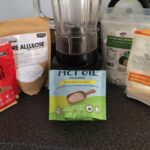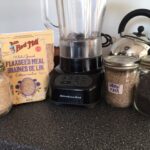Smoothies have an “aura” in the health space of being super nutritious and virtuous. Just say the word smoothie and you conjure up the image of a tall, thick, icy post-workout drink, sipped from an extra thick straw by a fit looking, maybe slightly glistening, perfect body exerciser. Like the picture here…
Or perhaps you get the image of the busy corporate exec, in their business attire, busy whirring up a concoction of uber-nutritious ingredients in their perfect granite counter-topped kitchen before they dash out the door to start their daily commute.
Or maybe you are thinking of the line-up at your favourite coffee shop or smoothie bar, where you can just order up one of their yummy combos and they can deal with the dirty dishes! For a hefty price, of course…
As you might be able to tell from the commentary above, I’m not a big fan of smoothies. But I also understand that a lot of people are, so it’s important to know how to make a keto compliant smoothie without sabotaging your health goals.
Why don’t I think that smoothies are the greatest thing since sliced bread? Several reasons… Firstly, they’re generally sweet. Really, “smoothie” has just become a synonym for “milkshake”, but without the ice cream. We base them on yogurt (often sweetened almost as much as ice cream) instead, and yogurt has carried a “healthy” halo for years. They are also usually based on a banana or other tropical fruit to give them additional sweetness. Never mind the addition of “healthy” honey, maple syrup or agave syrup!
Secondly, they are generally enormous and designed for you to sip at them for hours. This can provide a sense of fullness and satisfaction if you are someone who cannot manage to go for long without eating, or someone who uses a food/beverage for emotional/mental calming. But the practice of dribbling in calories over a long period of time is not in tune with how we evolved to eat. Instead of eating once, getting full and then not eating until truly experiencing hunger again, which is much more ancestrally appropriate and it’s the way that animals in nature will generally function, especially carnivorous animals, like us. Feast and rest, or feast and famine, if you’re unlucky in your hunt. Herbivores, on the other hand, tend to eat almost constantly because their food sources are so nutrient poor, so they “graze” for hours a day. Think about cows in the field, or gorillas eating leaves. Hours and hours spent eating, and enormous guts to hold all the intestines required to process all that roughage.
There are important health benefits to the feast and fast eating cycle, both in our guts and in terms of our hormonal responses to food energy. Whether we burn sugar calories or fat calories (from food or our own body stores) is dependent on that period between meals when we’re not eating. “Grazing” through a jumbo smoothie prevents the fasting or rest cycle from happening.
Third reason is that they are liquid. We simply don’t get the same satiety signals from liquid foods that we do from solids. No chewing, so no saliva production and early amylase production in our mouth to start the digestive process. Liquids slip right through our stomachs and dribble into the intestinal tract, so no protein digestion using our stomach acids and the enzymes such as pepsin that start to break large protein molecules into smaller peptides for easier digestion in the small intestine. Plus, the stomach is the organ that senses food intake and sends signals to the brain to start or stop eating, using hormones such as ghrelin to impact on appetite and hunger signals.
So, what’s a smoothie lover to do? How to stay true to lower carb or keto principles? Stay tuned…
Firstly, let’s talk about how you consume a smoothie. Make it a moderate size (8-12 oz/250-375 mls max). It doesn’t need to stand a foot tall on your desk all morning. Drink it as a meal, not a dribble. That means consume it in 20-30 minutes. Perhaps have a small amount of a solid food alongside the smoothie to allow the stomach to then have the sensation of a solid content, allowing for the appropriate hormonal response to the meal. Maybe a piece of a low carb bread or a hard-boiled egg. Even a piece of cheese will help. Having said that, if you toasted the piece of low carb bread, added peanut butter or the cheese or the hardboiled egg and ate it sitting down, you probably wouldn’t need the smoothie – LOL.
How to build a smoothie that’s going to make you feel happy but not knock your blood sugar out of the park? It comes down to choosing the right ingredients and playing around until you are happy with the result. Here’s my basic formula:
Something for protein:
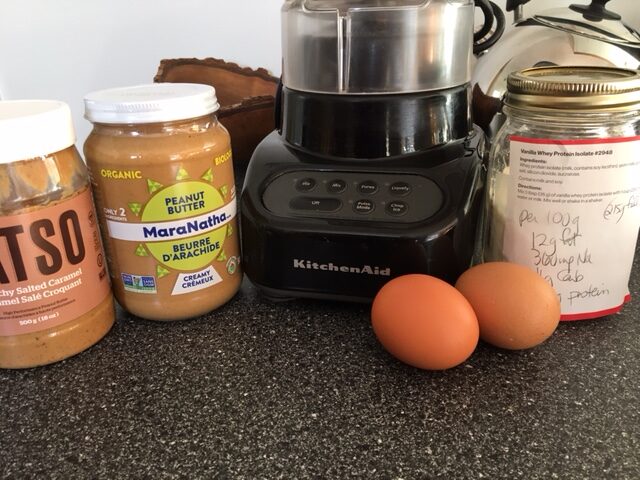
Satiety comes from protein, so a good protein source is important. Protein powders are often the basis of a smoothie and that’s fine, although they’re not a whole food, rather a highly processed food derivative. Alternatives can include peanut or almond butter, peanut butter powder or whole eggs. Before anyone gets all squidgy about using raw eggs, I will mention that there’s little risk to using raw eggs in this situation when the item being made is intended to be consumed immediately. Wash your egg before cracking to ensure that the shell is clean, and wash your blender well after using to ensure that no raw egg remains on the blades. Eggs are the ultimate perfect protein source as long as you treat them with the respect they deserve. That means buy the best eggs you can afford, wash them before cracking, use the resulting product right away – meaning within the hour. And keep it cool. If you are severely immune-compromised in any way, such as in the middle of chemo, don’t use raw eggs. It’s not worth the risk. Use one of the other protein ideas instead.
Something creamy:
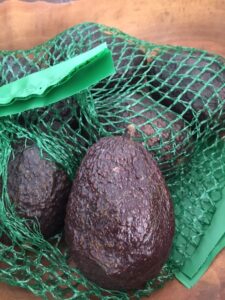
Bananas are not your friend in a keto smoothie world. The average banana has 27-29 g carb as sugar, of which 3 g are fibre. In contrast, a small avocado (of the kind that you can buy in the net bag) has about 9 g carb in 100g of avocado (the one pictured would be about 75g of flesh), of which 7g is dietary fibre. The avocado imparts healthy fats, a wonderful creaminess but no avocado flavour. Another alternative is full fat unflavoured Balkan style yogurt or Greek yogurt. The yogurts contribute additional protein and healthy probiotics as well as creaminess. Unsweetened kefir is another creamy contributor.
Yogurt is usually made from lowfat milk and may or may not contain healthy gut-friendly bacteria. Many cheaper yogurt brands depend on the addition of gelatin to give it the right texture instead of the fermentation process itself. And most flavoured yogurt is sweetened, either with sugar or with an artificial sweetener (factory-made, not plant-derived). A plain full-fat yogurt or a full fat Greek Yogurt are good protein choices for enriching a keto smoothie with creaminess, good probiotics and improved satiety, but low-fat, artificially sweetened commercial yogurts are a bit of a nutritional nothing and the sugary ones are totally inappropriate.
Something flavourful:
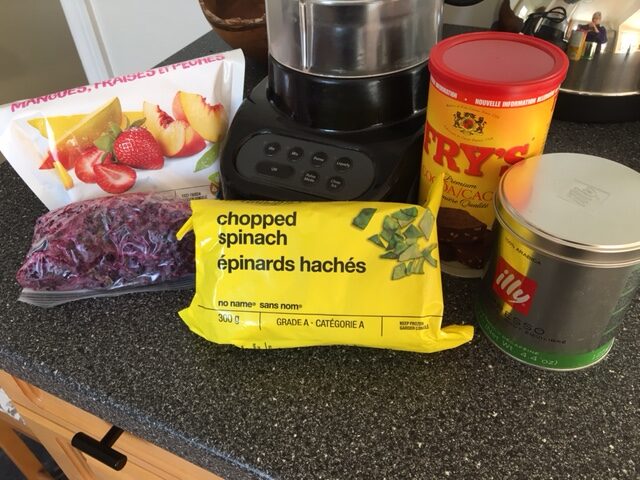
Smoothies seem to fall into two main categories – fruity or creamy. Fruity means that the flavour comes from plant foods – fruits, berries, leafy greens. To keep the carbs down in your smoothie, use only a small amount of fruit (about 1/4 cup) of unsweetened, fresh or frozen berries or small stone fruit such as cherries or peach. Avoid tropical fruits such as banana, pineapple or mango as these fruit contain a ton of sugar. You can also add leafy greens to a smoothie and get the benefits of these nutrient rich vegetables. Once blended well, the spinach or kale will basically disappear.
Creamy smoothies tend to be flavoured with chocolate, nut butters, perhaps coffee. Using cocoa powder adds a variety of minerals and phytochemicals, but not sugar or carbs. Another interesting flavour choice, with or without chocolate, is to use coffee to make a mocha flavour. Either instant coffee powder or a shot of espresso. Also, adding vanilla extract or almond extract will enhance the flavour. There’s no carb content in flavour extracts.
Something liquid:
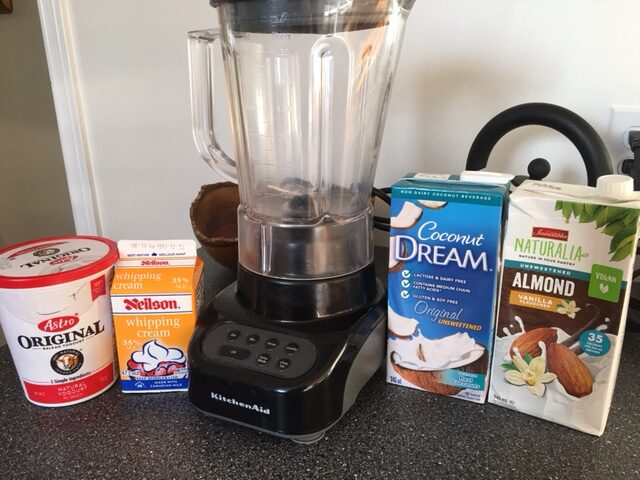
The best choice for liquid intake is usually water, and it isn’t any different here. If you have added the creamy factor, the protein factor and the flavour factor, then you can just add ice cubes or water if you choose. But other choices are a low carb nut milk or water with a shot of heavy cream. This is better than using regular milk because of the carb content of liquid milk.
Other add-ons:
If you need sweetness added to your smoothie, choose a non-nutritive (meaning low to no calorie/carb) sweetener that is derived from plants, not created artificially in the lab. So use stevia, monkfruit, erythritol or allulose. You can also add additional nutrients such as liquid Vitamin D or MCT oil or powder if desired.
You can also add something to boost the fibre content of your smoothie by adding flax meal, chia seed or even a bit of psyllium powder. Using too much of these products will mean that you need additional fluid, as they can cause it to gel into a pudding. Which is not the worst thing… Start with about a half tsp for a serving.
That’s the basic formula, but you will need to decide what makes you happy. The best way to include smoothies would be to make a smallish one and drink it in a short time frame. Avoid high carb ingredients, and ensure that there’s enough protein and fat to promote satiety. And maybe add it to something small but solid to slow down intestinal transit time.
Sip on!

